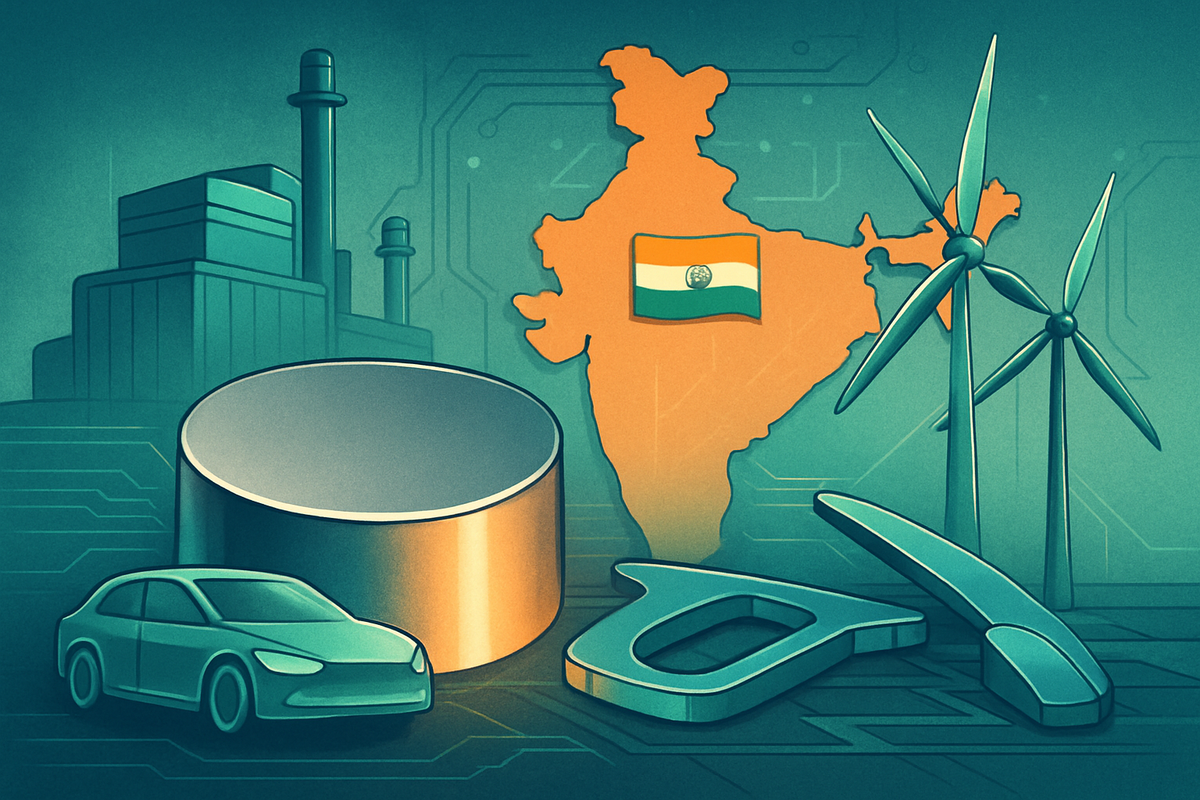
India is embarking on an ambitious journey to become a global player in rare earth magnet production, with the Ministry of Finance approving a substantial ₹7,300-crore scheme. This strategic initiative aims to significantly boost domestic manufacturing capabilities, reducing the nation's critical reliance on foreign supply chains, particularly from China, for these indispensable components. The move comes as a direct response to recent export restrictions imposed by Beijing, which highlighted India's vulnerability in key sectors like electric vehicles and renewable energy.
A Decisive Step Towards Self-Reliance
The newly approved scheme, a significant upgrade from an initial ₹1,345-crore proposal, is a seven-year plan with a total outlay of ₹7,300 crore. This includes ₹6,500 crore earmarked for capital expenditure and ₹800 crore for operational costs. Awaiting final Cabinet approval in the coming months, the scheme proposes to subsidize 30-50% of production costs for participating manufacturers. To qualify, companies must invest a minimum of ₹200 crore, with incentives potentially reaching 15% of their total investment. The ambitious production target is set at approximately 6,000 metric tonnes of rare earth magnets annually by 2030, a substantial leap from earlier goals and designed to meet India's projected domestic demand.
This initiative is a culmination of growing geopolitical concerns and economic vulnerabilities. China has long held a near-monopoly on the global rare earth supply chain, controlling 60-70% of production, 70-90% of processing, and 64-90% of magnet manufacturing. This dominance has allowed Beijing to wield significant geopolitical influence, as demonstrated by its export restrictions on rare earth elements and magnets in April 2025. These curbs caused immediate disruptions for Indian industries, particularly the EV sector, leading to critical shortages and increased component costs. Although some restrictions were temporarily lifted in August and September 2025, the incident served as a stark reminder of India's strategic dependence.
The scheme is designed for broad participation, extending eligibility to at least five companies, each capable of up to 1,200 metric tonnes of annual production. This expanded scope, influenced by industry feedback and the Prime Minister's Office, encourages both public and private sector manufacturers to undertake end-to-end processing, from rare earth oxides to finished magnets. Major industrial groups such as JSW, Mahindra, Kalyani, Sona Comstar (NSE: SONACOMS), Midwest Advanced Materials, Entellus, and Proterial have already expressed interest and contributed to the scheme's design. State-owned Indian Rare Earths Limited (IREL) is also a central player, actively seeking international partnerships and planning to shift from raw material exports to domestic processing for magnet production.
The Ministry of Finance's approval, as of October 8, 2025, signals India's decisive commitment to securing its critical materials supply chain. The expanded allocation and broader eligibility criteria underscore the government's intent to attract substantial investment and cultivate a competitive domestic rare earth magnet industry. This strategic move directly addresses the vulnerabilities exposed by China's past actions and positions India to achieve its ambitious goals in clean energy and advanced manufacturing, while simultaneously reducing its reliance on external, potentially volatile, supply sources. The coming months are expected to witness heightened activity from both public and private entities as they prepare to leverage these incentives to establish and scale rare earth magnet production facilities across the nation.
Companies Poised for Gains and Challenges
India's ₹7,300-crore rare earth magnet production scheme is set to significantly reconfigure the domestic industrial landscape, fostering self-reliance and reducing the nation's reliance on Chinese imports. This strategic initiative will create clear beneficiaries and potential challenges across various sectors, including mining, processing, magnet manufacturing, and critical end-use industries such as electric vehicles (EVs) and defense.
Among the primary beneficiaries are Indian rare earth mining and processing companies. IREL (India) Limited, as the sole public sector undertaking in this space, is poised to play a central role, increasing its neodymium production and supplying raw materials to domestic magnet manufacturers. Other mining conglomerates like Vedanta Group (NSE: VEDL), NALCO (National Aluminium Company Limited) (NSE: NALCO), and Gujarat Mineral Development Corporation (GMDC) (NSE: GMDCLTD) are actively exploring or establishing rare earth extraction and processing capabilities. Furthermore, PolyProtic Chemical India Limited stands to benefit with its R&D-led solutions for rare earth metal extraction and battery recycling, crucial for efficient domestic processing.
The scheme offers substantial incentives for companies venturing into rare earth magnet manufacturing. Midwest Advanced Materials Pvt Ltd (MAM) is expected to commence commercial production of Neodymium (NdFeB) magnets for EV motors by late 2025, aiming for significant capacity expansion by 2030, with IREL supplying the necessary raw materials. Leading auto component makers like Sona BLW Precision Forgings Ltd (Sona Comstar) (NSE: SONACOMS) and Uno Minda (NSE: UNOMINDA) have formally expressed interest in domestic rare earth magnet production. Automotive giant Mahindra & Mahindra (NSE: M&M) is also actively exploring local production to support its burgeoning EV portfolio. Diversified conglomerate JSW Group (NSE: JSWSTEEL) and UK-headquartered Entellus Industries with Indian operations are also keen participants. Additionally, Trafalgar, an Indian engineering firm, is establishing India's first rare earth metals, alloy, and magnet plant in Gujarat, targeting to meet a significant portion of domestic demand for sintered NdFeB magnets by 2027. Existing magnet manufacturers such as Kumar Magnet Industries and Dura Magnets Pvt Ltd could also benefit from the overall push for domestic production if they can scale and adapt.
End-use sectors, particularly EV manufacturers like Mahindra & Mahindra (NSE: M&M) and Maruti Suzuki (NSE: MARUTI), will gain immensely from a stable, domestic supply of rare earth magnets, mitigating import risks and price volatility. The defense sector, including public sector undertakings like Hindustan Aeronautics Limited (HAL) (NSE: HAL) and Bharat Dynamics Limited (NSE: BDL), along with private defense contractors, will achieve strategic independence through a secure domestic supply of samarium-cobalt (SmCo) magnets, vital for advanced defense systems.
Conversely, Chinese rare earth producers and exporters, who currently dominate the global market and supply a vast majority of India's rare earth magnet imports, are the most significant potential losers. India's scheme directly aims to reduce this reliance, leading to a decline in import volumes from China. An interesting dynamic is presented by Indian EV manufacturers adopting rare-earth-free technologies. Ola Electric, for instance, has received certification for its in-house developed rare-earth-free ferrite motor for two-wheeler EVs, significantly reducing its reliance on imported rare earth magnets. This innovation, while a win for Ola Electric in terms of cost and supply chain de-risking, means the company may not directly benefit from the rare earth magnet production scheme itself. TVS Motor Company (NSE: TVSMOTOR) is reportedly pursuing similar ferrite-based motor alternatives, potentially following Ola Electric's trajectory.
Internationally, non-Chinese rare earth suppliers and technology providers from regions such as Japan, the United States, and Australia are likely to see increased opportunities for collaboration, technology transfer, and potentially supplying India with rare earth materials or advanced processing know-how during the transition phase. India is actively seeking international partners and exploring rare earth resources globally, with Japanese entities already engaging in consultations and partnerships.
Wider Significance: De-risking Supply Chains and Green Energy Transition
India's ₹7,300-crore rare earth magnet production scheme carries profound wider significance, primarily addressing two critical global industry trends: de-risking supply chains and accelerating the green energy transition. The nation's heavy reliance on China for rare earth magnets, with Beijing supplying approximately 90% of India's needs and controlling over 90% of global processing capacity, was starkly exposed by China's export restrictions in April 2025. These curbs, which mandated export licenses and end-user certificates, caused immediate disruptions and price hikes for Indian industries. India's scheme directly aims to mitigate this vulnerability, aligning with a global trend among nations like the US, EU, and Japan to diversify critical mineral supply chains away from single-country dominance, thereby achieving strategic autonomy by fostering indigenous capabilities.
Furthermore, the initiative is a cornerstone of India's ambitious green energy transition. Rare earth permanent magnets, particularly those containing neodymium and dysprosium, are indispensable for high-performance motors in electric vehicles and generators in wind turbines. By securing a domestic supply, India aims to bolster its targets of 500 GW of non-fossil energy capacity and 30% EV penetration by 2030. This will enable domestic manufacturing of clean energy technologies, reducing reliance on imported components and supporting a greener, more sustainable energy landscape. Interestingly, efforts are also underway to explore rare-earth-free alternatives, with Ola Electric (NSE: OLAELECTRIC) having received certification for its in-house developed ferrite motor, which matches performance while lowering costs and further de-risking the supply chain.
The ripple effects of India's scheme are expected to be felt globally. For global competitors, primarily China, India's successful establishment of a domestic rare earth magnet industry could introduce a significant alternative supplier to the global market, gradually diminishing China's market dominance and strategic leverage. While this won't instantly negate China's position, it represents a long-term challenge to its control over this critical resource, potentially leading to increased competition and diversification of supply sources for other nations. For global partners like the US, Europe, Japan, and Australia, India's increased production capacity could offer a new, reliable source, strengthening geopolitical alliances focused on critical mineral security and accelerating the green energy transition by providing more stable access to essential materials. A more diversified global supply could also contribute to stabilizing rare earth magnet prices, reducing volatility.
From a regulatory and policy perspective, the Indian government's scheme is a comprehensive intervention. It includes fiscal incentives for capital and operational expenditures, aims to bridge cost gaps, and offers tariff relief on essential equipment. To facilitate private sector participation, India is implementing amendments to its mining laws, streamlining regulatory approvals, and removing certain critical minerals from the list of atomic materials to allow broader private involvement in exploration and mining. Public-private partnerships (PPPs) are also being encouraged. This scheme operates within the larger framework of India's National Critical Minerals Mission, which identifies 30 strategically important minerals for domestic development. Historical precedents, such as China's restriction of rare earth exports to Japan in 2010, underscore the geopolitical risks of over-reliance on a single supplier and have heavily influenced India's current drive. The shift from a historical state monopoly by IREL (India) Limited towards encouraging private sector involvement aims to overcome past limitations and unlock India's substantial rare earth potential.
What Comes Next: Charting India's Path to Rare Earth Magnet Sovereignty
The future of India's rare earth magnet production scheme is poised for significant growth and strategic development, driven by a robust governmental push for self-reliance and reduced dependence on China. In the short term (next 1-2 years), the immediate focus will be on the finalization and swift implementation of the ₹7,300-crore incentive scheme. With the Ministry of Finance's approval, final subsidy structures are expected to be solidified rapidly. This will pave the way for initial production from select manufacturers, with companies like Midwest Advanced Materials aiming for substantial output by late 2025 and into 2026. Indian Rare Earths Limited (IREL) will play a crucial role in supplying raw materials and its existing Rare Earth Permanent Magnet (REPM) plant in Visakhapatnam will contribute to samarium-cobalt magnet production. Addressing immediate supply gaps, India will continue to explore interim rare earth procurement from alternative countries like Japan and Vietnam while engaging in diplomatic efforts with China to streamline existing supply chains. The initial phase will specifically target neodymium and praseodymium-based magnets, vital for EVs and wind turbines.
Long-term possibilities (beyond 2 years) project India towards achieving complete self-reliance and potentially emerging as a significant global player. The ambitious goal is to establish an end-to-end domestic supply chain to meet projected demand of approximately 6,000 metric tonnes by 2030, transforming India into a reliable alternative in the global market. This will necessitate the expansion of mining and processing capabilities, leveraging India's substantial, yet underexplored, rare earth reserves. The National Critical Mineral Mission (NCMM) 2025 aims to accelerate exploration, and IREL plans to significantly increase its neodymium production. Investment in technological advancement and R&D will be crucial for improving processing techniques, developing sustainable methods, and exploring substitutes. The government is also considering strategic stockpiling of rare earths to cushion against future external shocks.
India's strategic pivots will include a clear shift from being a raw material exporter to a value-added manufacturer, as evidenced by IREL's instruction to halt rare earth exports to Japan to prioritize domestic needs. Diversification of supply chains through global partnerships, particularly with mineral-rich African nations and through participation in initiatives like the US-led Minerals Security Partnership (MSP), will be key. The government will continue to foster public-private partnerships, encouraging major Indian conglomerates and public sector entities to invest in rare earth exploration and processing.
Market opportunities are immense, driven by India's booming domestic demand from the rapidly growing EV market (targeting 30% penetration by 2030) and the expansion of renewable energy (500 GW non-fossil fuel capacity by 2030). Local production will enhance supply chain resilience, contribute to technological sovereignty in critical sectors like defense, and spur economic growth and job creation. Opportunities also exist in developing a circular economy through magnet recycling. However, significant challenges persist, primarily China's overwhelming dominance in the global rare earth value chain, which poses competitive and supply disruption risks. India also faces processing gaps, requires heavy capital investment, and must navigate environmental concerns and regulatory hurdles. The scarcity of heavy rare earths domestically, crucial for high-temperature magnets, might necessitate continued imports for specialized applications. Ensuring cost-competitiveness against cheaper Chinese imports will also be a major hurdle.
Potential scenarios range from an optimistic outcome where India emerges as a strong, diversified global rare earth magnet supplier, exceeding its 2030 production targets, to a challenging scenario where complexities, high costs, and global competition hinder rapid scaling, leaving India still significantly dependent on imports. A moderate scenario sees India achieving domestic self-sufficiency for light rare earth magnets with some niche export capabilities, gradually reducing its reliance on China but still facing challenges in heavy rare earth sourcing and advanced processing.
A Comprehensive Wrap-up: Forging a New Era of Critical Mineral Sovereignty
India's decisive move to launch a substantial ₹7,300-crore scheme for rare earth magnet production marks a pivotal moment in its quest for strategic independence and industrial advancement. This ambitious seven-year initiative, approved by the Ministry of Finance and awaiting final Cabinet approval, is a clear declaration of intent to secure critical supply chains and diminish a heavy reliance on China, which has long dominated the global rare earth market.
Key Takeaways: The core objective is to cultivate a robust domestic manufacturing base for rare earth magnets, components indispensable for electric vehicles (EVs), wind turbines, consumer electronics, and defense systems. The scheme boasts a significantly increased allocation of ₹7,300 crore, targeting an annual production capacity of approximately 6,000 metric tonnes by 2030, a substantial leap designed to meet India's burgeoning domestic demand. With broadened participation criteria, allowing at least five companies to be eligible for incentives, and comprehensive support across the entire value chain from raw material processing to finished magnet production, the initiative is strategically aligned with India's broader "National Critical Mineral Mission" (NCMM). State-owned IREL (India) Limited has been instructed to prioritize domestic supply of neodymium, a critical element, by halting exports.
Market Assessment Moving Forward: The Indian rare earth magnet market is on the cusp of significant transformation. Domestic demand, currently around 4,000 metric tonnes annually, is projected to double by the end of the decade, with EVs alone driving substantial requirements. While India possesses the world's third-largest rare earth reserves, historical underutilization, limited downstream processing capabilities, and technological gaps have kept its production share below 1% globally. However, the scheme creates immense opportunities, leveraging global efforts to diversify supply chains away from China and capitalizing on India's booming green energy sector and rising EV adoption. Challenges remain, including overcoming China's market dominance, bridging technological gaps, securing substantial capital investment, and navigating environmental concerns.
Significance and Lasting Impact: This rare earth magnet scheme holds profound significance for India's strategic autonomy and economic future. It directly enhances national security in critical sectors by reducing dependence on foreign sources, aligning with the "Make in India" and "Atmanirbhar Bharat" visions. It is poised to stimulate economic growth, foster industrialization, create jobs, and nurture indigenous innovation, positioning India as a global manufacturing hub for electronics and clean technology. Ultimately, establishing an integrated domestic rare earth value chain will build resilience against future global supply shocks and geopolitical tensions, while the focus on indigenous R&D and the proposed National Rare Earth Innovation Hub will significantly boost India's capabilities in advanced materials science and engineering.
Investor Watchpoints in Coming Months (as of 10/8/2025): Investors keenly observing India's rare earth magnet sector should closely monitor several key developments. The foremost is the final Cabinet approval and the detailed rollout of the ₹7,300-crore scheme, including granular details of the incentive disbursement mechanism. Tracking which private sector companies, such as Mahindra & Mahindra (NSE: M&M), Uno Minda (NSE: UNOMINDA), and Sona Comstar (NSE: SONACOMS), secure government incentives and formally announce their production facilities will be crucial. Progress of IREL (India) Limited in ramping up domestic processing and its role in supplying raw materials, alongside updates on rare earth exploration, will also be important. Investors should also watch for announcements regarding technological partnerships, particularly with international entities from Japan or other nations with advanced rare earth processing expertise, and progress on indigenous R&D efforts under the National Critical Mineral Mission. Compliance with domestic content requirements, global rare earth market dynamics (including prices and China's export policies), and the growth trajectory of India's EV, wind energy, and electronics manufacturing sectors will be key indicators for the long-term success and sustainability of this nascent but critical industry. Any further modifications to the Mines and Minerals (Development and Regulation) Act and the overall clarity of the regulatory framework will also shape investor confidence.
This content is intended for informational purposes only and is not financial advice





